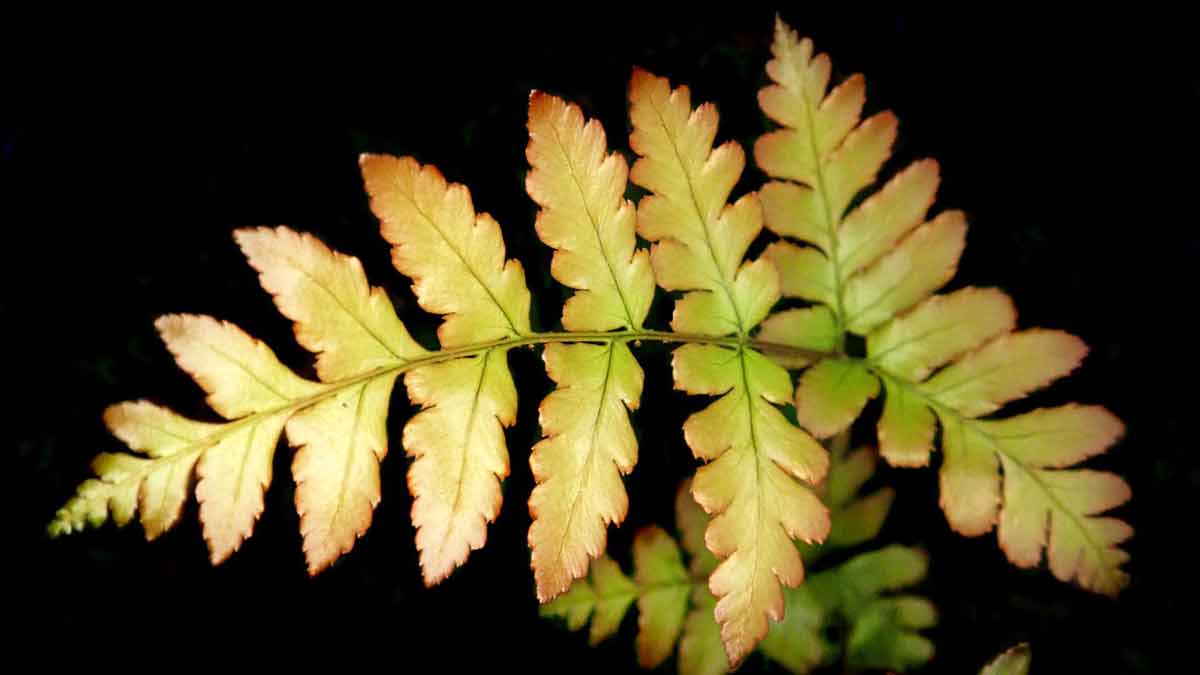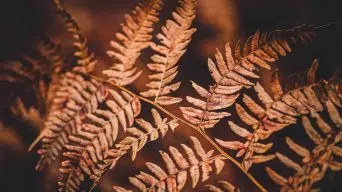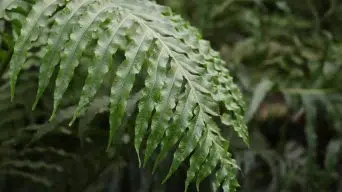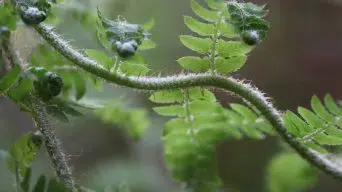Fern plants are beautiful, low-maintenance additions to any home.
But what do you do when your fern leaves start turning yellow?
There are a few different reasons why this may happen, including over- or underwatering, too much or too little light, and nutrient deficiencies.
Luckily, it’s usually easy to fix the problem and get your fern looking green and healthy again.
Here are the most common reasons why fern leaves turn yellow and what you can do about it.
What Causes Fern Leaves to Turn Yellow?
Are your fern leaves turning yellow? There are a few different reasons why this may be happening.
The most common are:
1. Overwatering
One of the most common reasons fern leaves turn yellow is that they get too much water.
Ferns like to be kept moist but not soggy.
If the soil is constantly wet, the roots can start to rot, which will cause the leaves to turn yellow and eventually die.
How To Tell If You’re Overwatering Your Fern
Here are some indicators that could suggest you’re giving your fern too much water:
- Yellow leaves. If the leaves are turning yellow and falling off, that’s a sign that you’re giving the plant too much water.
- Wilted leaves. If the leaves are wilted and droopy, that’s another sign of overwatering.
- Mushy soil. If the soil is soggy or feels mushy, it’s probably too wet.
- Fungus or mold. If you see fungus or mold growing on the soil, that’s another sign that it’s too wet.
How To Fix an Overwatered Fern
If you think you may be overwatering your fern, there are a few things you can do to fix the problem:
- Let the soil dry out. If the soil is too wet, stop watering the fern and let the pot drain completely.
- Repot in fresh, well-draining potting mix. If the fern grows in soggy soil, repot it in a fresh potting mix with good drainage.
- Cut back on watering. Water your fern less often, and ensure the soil can dry out between waterings.
- Increase drainage. If the pot doesn’t have good drainage, add some rocks or gravel to the bottom of the pot before adding the soil.
- Use a pot with drainage holes. Ensure the pot you’re using has drainage holes in the bottom to allow excess water to drain.
2. Underwatering
Another common reason fern leaves turn yellow is that they’re not getting enough water.
Ferns need at least 1 inch of water per week and more if they grow in a pot.
If the fern isn’t getting enough water, the leaves will turn yellow and eventually die.
How To Tell If You’re Underwatering Your Fern
There are a few signs that you are not providing enough water to your fern:
- Dry soil. If the soil is dry to the touch, that’s a sign that the fern needs water.
- Wilted leaves. If the leaves are wilted and droopy, that’s another sign of underwatering.
- Brown leaves. If the leaves are turning brown and crispy, that’s another sign that the fern needs more water.
How To Fix an Underwatered Fern
If you think you may be underwatering your fern, there are a few things you can do to fix the problem:
- Water more often. Water your fern at least once a week, and make sure the soil stays moist.
- Water deeply. When you water your fern, water it deeply so the water reaches the roots.
- Use a pot with drainage holes. Ensure the pot you’re using has drainage holes in the bottom to allow excess water to drain.
- Humidity. Ferns like high humidity, so misting or setting the plant on a pebble tray can help.
3. Too Little Light
Another common reason fern leaves turn yellow is that they’re not getting enough light.
Ferns need bright, indirect light to grow, and if they’re not getting enough, the leaves will start to turn yellow.
They need at least 4 hours of indirect light daily, but more is better.
How To Tell If Your Fern Is Not Getting Enough Light
There are a few signs that your fern isn’t getting enough light:
- Leaves are turning yellow. If the leaves turn yellow, that’s a sign that the plant isn’t getting enough light.
- Leaves are small. If the leaves are smaller than they should be, that’s another sign of too little light.
- New growth is slow. If the fern isn’t growing much new growth, that’s another sign that it’s not getting enough light.
How To Fix a Fern That’s Not Getting Enough Light
If you think your fern isn’t getting enough light, there are a few things you can do to fix the problem:
- Move the fern to a brighter spot. If the fern is in a low-light location, move it to a sunnier place.
- Increase the amount of light. If the fern is in a bright spot, you may need to increase the amount of light it’s getting. This can be done by adding more lights or moving the fern closer to a window.
- Filter the light. If the fern is in a spot with direct sunlight, filter the light with a sheer curtain or blind.
- Move the fern outdoors. If the fern is in a pot, you can move it outdoors for the summer. Just make sure to bring it back indoors before the first frost.
4. Too Much Sunlight
While ferns need bright indirect sunlight to grow, too much sun can be harmful. If the fern gets too much direct sunlight, the leaves will turn yellow, brown, and crisp.
Ferns grown outdoors in shady areas are less likely to get too much sun. But if you have an indoor or a fern in a bright spot, it’s essential to watch how much sun it’s getting.
How To Tell If Your Fern Is Getting Too Much Sunlight
There are a few signs that your fern is getting too much sun:
- Leaves are brown and crispy. If the leaves turn brown and crisp, it’s a sure sign that the fern is getting too much sun.
- The leaves are yellow. If the leaves turn yellow, it’s a sign that the fern is getting too much direct sunlight.
- The fern is wilting. If the fern is wilting, it’s a sign that it’s not getting enough water. However, if the fern is wilting and the leaves are turning yellow, it’s a sign that the fern is getting too much sun.
How To Fix a Fern That’s Getting Too Much Sunlight
If you think your fern is getting too much sun, there are a few things you can do to fix the problem:
- Move the fern to a shadier spot. If the fern is getting too much sun, move it to a shadier location.
- Add some shading. If you can’t move the fern, you can try adding some shading. This can be done with a piece of cloth or even an umbrella.
- Place the fern near a window. If the fern is in a spot with direct sunlight, try moving it near a window. An east- or west-facing window is ideal.
- Water the fern more frequently. If the fern is wilting, it may just need more water. Water the fern more regularly and ensure the soil is always moist but not soggy.
5. Nutrient Deficiencies
Ferns need nutrients to grow, and if they’re not getting enough, the leaves will turn yellow. Ferns’ most common nutrient deficiencies are nitrogen, phosphorus, and potassium.
Nitrogen is needed for the fern to produce new growth, phosphorus is required for root growth, and potassium is necessary for overall health.
Ferns grown in pots are more likely to suffer from nutrient deficiencies because the potting mix can deplete over time.
How To Tell If Your Fern Has a Nutrient Deficiency
There are a few signs that your fern has a nutrient deficiency:
- Yellowing leaves. If the leaves turn yellow, it’s a sign that the fern is not getting enough nitrogen.
- Leaves are small. If the leaves are smaller than they should be, it’s a sign that the fern is not getting enough phosphorus.
- Leaves are brown and crispy. If the leaves are brown and crispy, it’s a sign that the fern is not getting enough potassium.
- There is no new growth. If there is no new growth, it’s a sign that the fern is not getting enough nitrogen.
How To Fix a Fern With a Nutrient Deficiency
If you think your fern has a nutrient deficiency, there are a few things you can do to fix the problem:
- Fertilize the fern. Use a fertilizer that’s high in nitrogen, phosphorus, and potassium. Follow the directions on the package, and fertilize the fern every two weeks.
- Repot the fern. If the fern is in a pot, repot it in fresh potting mix. This will give the fern a boost of nutrients.
- Give the fern more light. Ferns that grow in low light are more likely to suffer from nutrient deficiencies. Give the fern more light, and it may start to produce new growth.
6. Overfertilization
Ferns need nutrients to grow, but they don’t need a lot. If you fertilize the fern too frequently or use too much fertilizer, the leaves will start to turn yellow.
Ferns must be fertilized every two weeks during the growing season with a fertilizer high in nitrogen.
How To Tell If Your Fern Is Overfertilized
There are a few signs that your fern is overfertilized:
- Yellow leaves. If the leaves turn yellow, it’s a sign that the fern is getting too much fertilizer.
- Leaves are small. If the leaves are smaller than they should be, it’s a sign that the fern is getting too much fertilizer.
- A fertilizer burn is visible on the leaves. If you see brown or white spots on the leaves, it’s a sign of fertilizer burn. This happens when the fern is getting too much fertilizer.
- The roots are mushy. If the roots are mushy, it’s a sign that the fern is getting too much fertilizer.
How To Fix an Overfertilized Fern
If you think your fern is overfertilized, there are a few things you can do to fix the problem:
- Stop fertilizing the fern. Cut back every two weeks if you’re fertilizing the fern every week. If you’re using a liquid fertilizer, dilute it by half.
- Flush the potting mix. If the fern is in a pot, flush the potting mix with water to remove any excess fertilizer. To do this, water the fern until the water runs out of the drainage holes.
- Repot the fern. If the fern is in a pot, repot it in fresh potting mix. This will help to remove any excess fertilizer from the roots.
7. Low Humidity
Ferns need high humidity to grow, and if the air is too, the leaves will start to turn yellow.
Fern plants are native to tropical environments, which means they’re used to high humidity. Ferns grow in humid areas like rainforests and swampy areas in the wild.
The ideal humidity for ferns is between 60% and 80%.
How To Tell If Your Fern Needs More Humidity
There are a few signs that your fern needs more humidity:
- Leaves are dry. If the leaves are dry, it’s a sign that the air is too low in moisture.
- Leaves are brown and crispy. If the leaves are brown and crispy, it’s a sign that the air is too low in humidity.
- Leaves are turning yellow. If the leaves turn yellow, it’s a sign that the fern is not getting enough moisture.
- There is no new growth. If there is no new growth, it’s a sign that the fern is not getting enough moisture.
How To Fix a Fern That Needs More Humidity
If you think your fern needs more humidity, there are a few things you can do to fix the problem:
- Mist the fern. Misting the fern will increase the humidity around the plant. Mist the fern every day, or use a humidifier.
- Group plants together. Grouping plants together will create a microclimate around the plants that is more humid.
- Place the fern on a tray of pebbles. Place the fern on a tray of pebbles, and add water to the tray so that the water level is just below the top of the pebbles. As the water evaporates, it will increase the humidity around the fern.
8. Temperature Stress
Ferns need to be grown in warm, humid conditions; if the temperature is too cold or too hot, the leaves will start to turn yellow.
The ideal temperature for ferns is between 60°F and 80°F.
The leaves will turn yellow and brown if the temperature is too cold. This is because the fern cannot photosynthesize appropriately in cold temperatures.
The leaves will turn yellow and crispy if the temperature is too hot. This is because the fern is losing moisture through its leaves faster than it can replace it.
How To Tell If Your Fern Is Stressed By Temperature
There are a few signs that the temperature stresses your fern:
- Leaves are yellow and brown. If the leaves are yellow and brown, it’s a sign that the fern is too cold.
- Leaves are yellow and crispy. If the leaves are yellow and crispy, it’s a sign that the fern is too hot.
- There is no new growth. If there is no new growth, it’s a sign that the fern is not getting enough light.
- The fern is wilting. If the fern is wilting, it’s a sign that it’s not getting enough water.
How To Fix a Fern That Is Stressed By Temperature
If you think the temperature stresses your fern, there are a few things you can do to fix the problem:
- Move the fern to a warmer location. If the fern is too cold, move it to a warmer place.
- Move the fern to a cooler location. If the fern is too hot, move it to a cooler place.
- Increase the humidity around the fern. Increasing the humidity will help to keep the fern cool in hot weather and warm in cold weather.
- Make sure the fern is getting enough water. Ferns need to be kept moist, so make sure you’re watering the fern regularly.
9. Pest Infestation
Ferns can be susceptible to pests, and if your fern has a pest infestation, the leaves will start to turn yellow.
There are a few pests that can attack ferns:
- Mealybugs. Mealybugs are small, white insects that feed on the sap of plants. They can cause the leaves to turn yellow and crispy.
- Aphids. Aphids are small, green insects that feed on the sap of plants. They can cause the leaves to turn yellow and curl up.
- Spider mites. Spider mites are tiny, red insects that feed on the sap of plants. They can cause the leaves to turn yellow and fall off.
- Fungus gnats. Fungus gnats are small, black insects that feed on the roots of plants. They can cause the fern to wilt and yellow leaves.
How To Tell If Your Fern Has a Pest Infestation
There are a few signs that your fern has a pest infestation:
- Leaves are yellow and crispy. If the leaves are yellow and crispy, it’s a sign that the fern has mealybugs.
- Leaves are yellow and curled up. If the leaves are yellow and curled up, it’s a sign that the fern has aphids.
- Leaves are yellow and falling off. If the leaves are yellow and falling off, it’s a sign that the fern has spider mites.
- The fern is wilting. If the fern is wilting, it’s a sign that the fern has fungus gnats.
- The leaves have holes in them. If the leaves have holes, it’s a sign that the fern has caterpillars.
How To Fix a Fern That Has a Pest Infestation
If you think your fern has a pest infestation, there are a few things you can do to fix the problem:
- Remove the pests by hand. If you see pests on the fern, you can remove them by hand.
- Spray the fern with water. Spraying the fern with water will knock the pests off of the leaves.
- Use neem oil. Neem oil is a natural pesticide that will kill pests.
- Use insecticidal soap. Insecticidal soap is a pesticide that will kill pests.
10. Disease
Ferns can be susceptible to diseases, and if your fern has an infection, the leaves will start to turn yellow.
There are a few diseases that can affect ferns:
- Powdery Mildew. Mildew is a white, powdery fungus that grows on the leaves of plants. It can cause the leaves to turn yellow and brown.
- Rust. Rust is a red or orange fungus that grows on the leaves of plants. It can cause the leaves to turn yellow and fall off.
- Leaf Spot. Leaf spot is a brown or black fungus that grows on the leaves of plants. It can cause the leaves to turn yellow and fall off.
- Blight. Blight is a fungus that affects the stems and leaves of plants. It can cause the fern to wilt and the leaves to turn yellow.
How To Tell If Your Fern Has a Disease
There are a few signs that your fern has a disease:
- Leaves are yellow and brown. If the leaves are yellow and brown, it’s a sign that the fern has powdery mildew.
- Leaves are yellow and falling off. If the leaves are yellow and falling off, it’s a sign that the fern has rust.
- Leaves have brown or black spots. If the leaves have brown or black spots, it’s a sign that the fern has leaf spot.
- The fern is wilting. If the fern is wilting, it’s a sign that the fern has blight.
How To Fix a Fern That Has a Disease
If you think your fern has a disease, there are a few things you can do to fix the problem:
- Remove the affected leaves. If you see leaves that are affected by the disease, you can remove them from the plant.
- Dispose of the affected leaves. Once you’ve removed the affected leaves, you should dispose of them, so the disease doesn’t spread.
- Spray the fern with water. Spraying the fern with water will help remove the leaves’ spores.
- Use a fungicide. Fungicides are chemicals that will kill fungi.
- Use a copper fungicide. Copper fungicides are chemicals that will kill fungi.
11. Natural Leaf Yellowing
Ferns will naturally turn yellow and brown as they age.
As ferns age, the leaves will start to die off, and new leaves will grow.
This is a normal process; you don’t need to worry about it.
How To Tell If Your Fern Is Turning Yellow Naturally
There are a few signs that your fern is turning yellow naturally:
- The fern is producing new leaves. If the fern grows new leaves, it’s a sign that it’s turning yellow naturally.
- The fern is getting taller. If the fern is getting taller, it’s a sign that it’s turning yellow naturally.
- There is no evidence of other problems. If there is no evidence of other issues, it’s a sign that the fern is turning yellow naturally.
How To Fix a Fern That Is Turning Yellow Naturally
If you think your fern is turning yellow naturally, there are a few things you can do to fix the problem:
- Prune the fern. Pruning the fern will help to remove the old leaves and encourage new growth.
- Fertilize the fern. Fertilizing the fern will help to encourage new growth.
- Provide the fern with more light. Providing the fern with more light will help to encourage new growth.
- Give the fern a new pot. Giving the fern a new pot will help to encourage new growth.
Final Thoughts
If your fern leaves turn yellow, it could be due to several factors.
The most important thing is to pay attention to the individual plant and identify possible causes.
Once you’ve done that, you can take steps to correct the problem and get your fern looking healthy again.
With proper care, ferns can be long-lasting, low-maintenance houseplants.
They’re an excellent option for anyone looking to add a bit of greenery to their home without putting in too much effort.







